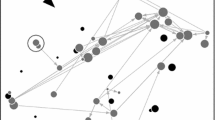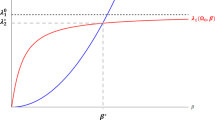Abstract
Movement has broad implications for many areas of biology, including evolution, community and population ecology. Movement is crucial in metapopulation ecology because it facilitates colonization and reduces the likelihood of local extinction via rescue effects. Most metapopulation modeling approaches describe connectivity using pair-wise Euclidean distances resulting in the simplifying assumption of a symmetric connectivity pattern. Yet, assuming symmetric connectivity when populations show net asymmetric movement patterns may result in biased estimates of colonization and extinction, and may alter interpretations of the dynamics and conclusions regarding the viability of metapopulations. Here, we use a 10-year time series on a wind-dispersed orchid Lepanthes rupestris that anchors its roots in patches of moss growing on trees or boulders along streams, to test for the role of connectivity asymmetries in explaining the colonization−extinction dynamics of this orchid in a network of 975 patches. We expected that wind direction could highly alter dispersal direction in this orchid. To account for this potential asymmetry, we modified the connectivity measure traditionally used in metapopulation models to allow for asymmetric effective distances between patches and subsequently estimated colonization and extinction probabilities using a dynamic occupancy modeling approach. Asymmetric movement was prevalent in the L. rupestris metapopulation and incorporating potential dispersal asymmetries resulted in higher colonization estimates in larger patches and more accurate models. Accounting for dispersal asymmetries may reveal connectivity effects where they were previously assumed to be negligible and may provide more reliable conclusions regarding the role of connectivity in patch dynamics.





Similar content being viewed by others
References
Ackerman JD (1995) An orchid flora of Puerto Rico and the Virgin Islands. Mem NY Bot Gard 73:1–208
Armsworth PR, Roughgarden JE (2005) The impact of directed versus random movements on population dynamics and biodiversity patterns. Am Nat 165:449–465
Batty AL, Dixon KW, Sivasithamparam K (2000) Soil seed bank dynamics of terrestrial orchids. Lindleyana 15:227–236
Beger M, Linke S, Watts M, Game ET, Treml E, Ball I, Possingham HP (2010) Incorporating asymmetric connectivity into spatial decision making for conservation. Conserv Lett 3:359–368
Bode M, Burrage K, Possingham HP (2008) Using complex network metrics to predict the persistence of metapopulations with asymmetric connectivity patterns. Ecol Model 214:201–209
Brown JH, Kodric-Brown A (1977) Turnover rates in insular biogeography: effect of immigration on extinction. Ecology 58:445–449
Burham KP, Anderson DR (2002) Model selection and multimodel inference: a practical information-theoretic approach. Springer, New York
Chardon JP, Adriaensen F, Matthysen E (2003) Incorporating landscape elements into a connectivity measure: a case study for the speckled wood butterfly (Pararge aegeria L.). Landsc Ecol 18:561–573
Clobert J, Danchin E, Dhondt A (2001) Dispersal. Oxford University Press, Oxford
Ferraz G, Nichols JD, Hines JE, Stouffer PC, Bierregaard RO, Lovejoy TE (2007) A large-scale deforestation experiment: effects of patch area and isolation on Amazon birds. Science 315:238–241
Ferreras P (2001) Landscape structure and asymmetrical inter-patch connectivity in a metapopulation of the endangered Iberian lynx. Biol Conserv 100:125–136
Fiske I, Chandler R (2011) Unmarked: an R package for fitting hierarchical models of wildlife occurrence and abundance. J Stat Softw 43:1–23
Fletcher RJ Jr (2009) Does attraction to conspecifics explain the patch-size effect? An experimental test. Oikos 118:1139–1147
Fletcher RJ, Acevedo MA, Reichert BE, Pias KE, Kitchens WM (2011) Social network models predict movement and connectivity in ecological landscapes. Proc Natl Acad Sci 108:19282–19287
García-Cancel JG, Meléndez-Ackerman EJ, Olaya-Arenas P, Merced A, Flores NP, Tremblay RL (2014) Associations between Lepanthes rupestris orchids and bryophyte presence in the Luquillo Experimental Forest, Puerto Rico. Carib Nat 6:1–14
Gilpin ME, Diamond JM (1976) Calculation of immigration and extinction curves from the species-area-distance relation. Proc Natl Acad Sci 73:4130–4134
Gustafson EJ, Gardner RH (1996) The effect of landscape heterogeneity on the probability of patch colonization. Ecology 77:94–107
Hanski I (1994) A practical model of metapopulation dynamics. J Anim Ecol 63:151–162
Hanski I (1998) Metapopulation dynamics. Nature 396:41–49
Hanski I (1999) Metapopulation ecology. Oxford University Press, Oxford
Hazell P, Kellner O, Rydin H, Gustafsson L (1998) Presence and abundance of four epiphytic bryophytes in relation to density of aspen (Populus tremula) and other stand characteristics. For Ecol Manage 107:147–158
Hovestadt T, Binzenhöfer B, Nowicki P, Settele J (2011) Do all inter-patch movements represent dispersal? A mixed kernel study of butterfly mobility in fragmented landscapes. J Anim Ecol 80:1070–1077
Johnson SL, Covich AP, Crowl TA, Estrada-Pinto A, Bithorn J, Wurtsbaugh WA (1998) Do seasonality and disturbance influence reproduction in freshwater atyid shrimp in headwater streams, Puerto Rico? Verhandl Int Verein Theor Angew Limnol 26:2076–2081
Kadoya T, Washitani I (2012) Use of multiple habitat types with asymmetric dispersal affects patch occupancy of the damselfly Indolestes peregreinus in a fragmented landscape. Basic Appl Ecol 13:178–187
Kawecki TJ, Holt RD (2002) Evolutionary consequences of asymmetric dispersal rates. Am Nat 160:333–347
Kindlmann P, Melandez-Ackerman EJ, Tremblay RL (2014) Disobedient epiphytes: colonization and extinction rates in a metapopulation of Lepanthes rupestris (Orchidaceae) contradict theoretical predictions based on patch connectivity. Linn J Bot Soc 175:598–606
Kleinhans D, Jonsson PR (2011) On the impact of dispersal asymmetry on metapopulation persistence. J Theor Biol 290:37–45
Lomolino MV (1990) The target area hypothesis: the influence of island area on immigration rates of non-volant mammals. Oikos 57:297–300
MacKenzie DI, Nichols JD, Hines JE, Knutson MG, Franklin AB (2003) Estimating site occupancy, colonization, and local extinction when a species is detected imperfectly. Ecology 84:2200–2207
McCormick MK, Jacquemyn H (2013) What constrains the distribution of orchid populations? New Phytol. doi:10.1111/nph.12639
McCormick MK, Taylor DL, Juhaszova K, Burnett RK, Whigham DF, O’Neill JP (2012) Limitations on orchid recruitment: not a simple picture. Mol Ecol 21:1511–1523
Moilanen A (1999) Patch occupancy models of metapopulation dynamics: efficient parameter estimation using implicit statistical inference. Ecology 80:1031–1043
Moilanen A (2002) Implications of empirical data quality to metapopulation model parameter estimation and application. Oikos 96:516–530
Moilanen A, Hanski I (1998) Metapopulation dynamics: effects of habitat quality and landscape structure. Ecology 79:2503–2515
Moilanen A, Nieminen M (2002) Simple connectivity measures in spatial ecology. Ecology 83:1131–1145
Olaya-Arenas P, Meléndez-Ackerman E, Pérez ME, Tremblay RL (2011) Demographic response by a small epiphytic orchid. Am J Bot 98:2040–2048
Pavlacky DC, Possingham HP, Lowe AJ, Prentis PJ, Green DJ, Goldizen AW (2012) Anthropogenic landscape change promotes asymmetric dispersal and limits regional patch occupancy in a spatially structured bird population. J Anim Ecol 8:940–952
Pellet J, Fleishman E, Dobkin DS, Gander A, Murphy DD (2007) An empirical evaluation of the area and isolation paradigm of metapopulation dynamics. Biol Conserv 136:483–495
Pollock KH (1982) A capture-recapture design robust to unequal probability of capture. J Wildl Manage 46:752–757
Prevedello JA, Viera MV (2010) Does the type of matrix mater? A quantitative review of the evidence. Biodivers Conserv 19:1205–1223
Ramírez A, Melendez-Colom E (2003) Meteorological summary for El Verde Field Station: 1975-2003. Institute for Tropical Ecosystem Studies, University of Puerto Rico
Rasmussen HN, Whigham DF (1993) Seed ecology of dust seeds in situ: a new study technique and its application in terrestrial orchids. Am J Bot 80:1374–1378
Rota C, Fletcher RJ, Dorazio R, Betts M (2009) Occupancy estimation and the closure assumption. J Appl Ecol 46:1173–1181
Royle JA, Dorazio RM (2008) Hierarchical modeling and inference in ecology: the analysis of data from populations, metapopulations and communities. Academic Press, San Diego
Salomon Y, Connolly SR, Bode L (2010) Effects of asymmetric dispersal on the coexistence of competing species. Ecol Lett 13:432–441
Sawyer SC, Epps CW, Brashares JS (2011) Placing linkages among fragmented habitats: do least-cost models reflect how animals use landscapes? J Appl Ecol 48:668–678
Snäll T, Pennanen J, Kivistö L, Hanski I (2005) Modelling epiphyte metapopulation dynamics in a dynamic forest landscape. Oikos 109:209–222
Tilman D, May RM, Lehman CL, Nowak MA (1994) Habitat destruction and the extinction debt. Nature 371:65–66
Tremblay RL (1997) Distribution and dispersion patterns of individuals in nine species of Lepanthes (Orchidaceae). Biotropica 29:38–45
Tremblay RL (2000) Plant longevity in four species of Lepanthes (Pleurothallidinae; Orchidaceae). Lindleyana 15:257–266
Tremblay RL, Ackerman JD (2001) Gene flow and effective population size in Lepanthes (Orchidaceae): a case for genetic drift. Biol J Linn Soc 72:47–62
Tremblay RL, Ackerman JD (2003) The genetic structure of orchid populations and its evolutionary importance. Lankesteriana 7:87–92
Tremblay RL, Castro JV (2009) Circular distribution of an epiphytic herb on trees in a subtropical rain forest. Trop Ecol 50:211–217
Tremblay RL, Meléndez-Ackerman E, Kapan D (2006) Do epiphytic orchids behave as metapopulations? Evidence from colonization, extinction rates and asynchronous population dynamics. Biol Conserv 129:70–81
Treml EA, Halpin PN, Urban DL, Pratson LF (2008) Modeling population connectivity by ocean currents, a graph-theoretic approach for marine conservation. Landsc Ecol 23:19–36
Vuilleumier S, Fontanillas P (2007) Landscape structure affects dispersal in the greater white-toothed shrew: inference between genetic and simulated ecological distances. Ecol Model 201:369–376
Vuilleumier S, Possingham HP (2006) Does colonization asymmetry matter in metapopulations? Philos Trans R Soc B 273:1637–1642
Vuilleumier S, Bolker BM, Lévêque O (2010) Effects of colonization asymmetries on metapopulation persistence. Theor Popul Biol 78:225–238
Whigham DF, O’Neill JP, Rasmussen HN, Caldwell BA, McCormick MK (2006) Seed longevity in terrestrial orchids-potential for persistent in situ seed banks. Biol Conserv 129:24–30
Winfree R, Dushoff J, Crone EE, Schultz CB, Budny RV, Williams NM, Kremen C (2005) Testing simple indices of habitat proximity. Am Nat 165:707–717
Acknowledgments
This work greatly benefited from discussions with B. Bolker and S. Vuilleumier. We thank J. C. Smith, K. Sieving, M. Oli and R. Holt for their suggestions. Funding was provided by the National Science Foundation (NSF) Quantitative Spatial Ecology, Evolution and Environment Integrative Graduate Education and Research Traineeship Program grant 0801544 at the University of Florida and an NSF Doctoral Dissertation Improvement Grant (DEB-1110441). Funding was also provided by the School of Natural Resources and Environment and the Department of Wildlife Ecology and Conservation at the University of Florida. R. Tremblay was supported by the Center for Applied Tropical Ecology and Conservation, NSF-HRD 0734826. The experiments comply with the current laws of the country (Puerto Rico) in which the experiments were performed.
Author information
Authors and Affiliations
Corresponding author
Additional information
Communicated by John Thomas Lill.
Electronic supplementary material
Below is the link to the electronic supplementary material.
Rights and permissions
About this article
Cite this article
Acevedo, M.A., Fletcher, R.J., Tremblay, R.L. et al. Spatial asymmetries in connectivity influence colonization−extinction dynamics. Oecologia 179, 415–424 (2015). https://doi.org/10.1007/s00442-015-3361-z
Received:
Accepted:
Published:
Issue Date:
DOI: https://doi.org/10.1007/s00442-015-3361-z




